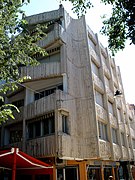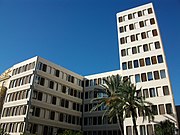Miguel Fisac
| Miguel Fisac | |
|---|---|
 Fotografía de Miguel Fisac, hacia 1950 | |
| Born | 29 September 1913 Daimiel |
| Died | 12 May 2006 Madrid |
| Occupation | Architect |
| Works | Moroder Building, headquarters of Secretaría General de Pesca del Ministerio de Agricultura, Alimentación y Medio Ambiente, iglesia de Santa Ana y Nuestra Señora de la Esperanza |
| Website | http://fundacionfisac.com/la-fundacion/origen-y-estructura-2/ |
Miguel Fisac (1913–2006) was a Spanish architect, urban planner, and painter.[1][2] He was a member of Opus Dei.[3]
Biography[]
Miguel Fisac Serna was born 29 September 1913 in Daimiel in Spain.[4][1] His father was Joaquín Fisac, his mother Amparo Serna.[5] He had two older brothers.[3] He moved to Madrid aged 17 to study architecture, but fled to France during the Civil War. He returned after the war, and graduated from ETSAM in 1942.[3]
He was member of Opus Dei from 1935 till 1955, when he left the organisation.[3][1] He died 12 May 2006 in Madrid.[4]
Gallery[]
Edificio Moròder, València
Indonesian embassy, Madrid

Laboratorios Jorba, Madrid (demolished)

Iglesia de San Pedro Mártir, Madrid

Edificio de Viviendas del Parterre, Daimiel
Works[]
- Centro de Estudios Hidrográficos, Madrid (1963)[6]
- Laboratorios Jorba, Madrid, known as La Pagoda (1967, demolished 1999)[1][2]
References[]
- ^ Jump up to: a b c d Copertone, Carlos; Eguiluz, Patxi. "Miguel Fisac". Retrieved 26 August 2019.
- ^ Jump up to: a b Meades, Jonathan (26 August 2019). "From bombs to Benidorm: how fascism disfigured the face of Spain". Retrieved 26 August 2019.
- ^ Jump up to: a b c d "Architects of Madrid: Miguel Fisac". Retrieved 26 August 2019.
- ^ Jump up to: a b "Miguel Fisac Serna (1913 - 2006)". Retrieved 26 August 2019.
- ^ "Cronología". Retrieved 26 August 2019.
- ^ "Edificio del Centro de Estudios hidrográficos". Retrieved 26 August 2019.
External links[]
- Fundación Fisac
 Media related to Miguel Fisac at Wikimedia Commons
Media related to Miguel Fisac at Wikimedia Commons
Categories:
- 1913 births
- 2006 deaths
- Spanish architects




